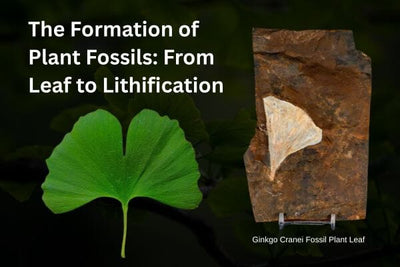Plant fossils show us the quiet story of Earth’s old forests. Leaves, stems, and seeds change into stone over many years. When people learn how fossils form, they can figure out what the climate used to be like. Collectors get to keep a real part of natural history. A fossil is more than a sign of past plant life; it also allows us to see the chemicals and environments on Earth from a long time ago.
1. Rapid Burial — Nature's First Step in Preservation
For a plant to turn into a fossil, it must not break down like it usually does. The most important thing is that it gets buried fast. If leaves or branches get covered by mud, silt, or volcanic ash before air and tiny living things reach them, they are saved from decay.
Key conditions for preservation:
-
Fine-grained sediments, such as clay or silt, cover delicate features like leaf veins and protect them.
-
A place with low oxygen slows down the breakdown and reduces the activity of bacteria.
-
When something gets buried fast, it does not face weather, scavengers, or erosion.
Without these protections, plants would decompose and return to the soil. There would be nothing
left to show they were ever there.
2. Compression and Carbonization — When Time Leaves Its Mark
When layers of sediment build up, they press down on the layers beneath them. The water and other gases are pushed out. A thin, dark film rich in carbon is left behind. This is called carbonization.
This process creates:
-
Flat impressions show the shape or the edge of leaves and stems.
-
Carbon films keep fine surface marks, sometimes showing single-cell edges.
Fossilized ferns and old leaves found in Carboniferous rock often exhibit this kind of preservation, allowing us to see amazing details of ancient plant parts.
3. Permineralization — Minerals Reinforce the Organic Structure
In some cases, water that is rich in minerals moves through buried plants. Minerals like silica or calcite fill the small spaces in the tissue of the plant. These minerals help maintain the plant’s strong shape. This process is known as permineralization. It produces strong 3D fossils, such as petrified wood.
In permineralized fossils:
-
The soft parts in bones or plants are replaced with rock by minerals. The shape stays the same.
-
The fossil you obtain from this is strong and appears very realistic. Sometimes, it still has bright natural colors.
-
Specimens with silica may exhibit colors such as red, brown, or gold. It depends on what minerals are in the ground.
4. Impressions, Molds, and Casts — The Many Forms of Fossilization
Not all plant fossils are made the same way. The location where the plant was buried, including the type of ground, the minerals in the area, and the depth at which it was placed in the Earth, all contribute to determining how the fossil is preserved over time.
Common fossil forms include:
-
Impressions: A leaf or stem outline is made when it is pressed into rock.
-
Molds: A hollow space is left over after a plant breaks down and dies.
-
Casts: A mold is filled with minerals, turning into a stone copy of the plant.
-
Petrified wood: This is plant tissue that has been transformed into stone, yet still retains its original shape, grain, and rings.
Each type shows something different about old plant life. You can see the feel of ferns and what old trees were made of. This helps us know more about plants from long ago.
5. Geological and Chemical Influences
Fossilization is both a chemical and a geological process. The way a plant fossil is kept safe depends on several things in the environment:
-
Sediment composition: Fine clays help retain more detail, but coarse sands can obscure some features.
-
Mineral-rich water: The water that has silica, calcite, and pyrite often leads to the process where minerals fill the fossil parts.
-
Pressure and temperature: A moderate level can cause rock to form and not break the weak remains.
-
pH and oxygen levels: A pH in the middle and low oxygen levels are best for keeping fossils in one piece.
These things demonstrate why some ancient ecosystems, such as the Carboniferous coal forests, have preserved plant remains in remarkably good condition. You can still see tiny details in these plants even now.
6. Modern Discoveries and the Value of Plant Fossils
Examining plant fossils can help us understand how ancient ecosystems evolved. It shows us how plants adapt to changes in weather and the need to grow in new ways. Here are some well-known examples:
-
Fossilized ferns reveal the appearance of early plants with veins.
-
Ginkgo leaves are from a type of tree family that has been around for a long time and is still growing now.
-
Petrified wood allows people to see nature's art through the way minerals have brought out color and texture in the wood.
Collectors and researchers like these samples for their beauty. They also value them because they give us important clues about life on Earth in the past.
Conclusion: Preserving Earth’s Green Past
The path a leaf takes to become stone shows how nature keeps its story alive over time. Through changes in rocks and minerals, soft plants turn into a record of what happened and how things changed in the past.
Fossil Age Minerals boasts a remarkable collection of authentic plant fossils. It features items such as ferns, ginkgo leaves, and pieces of petrified wood. The team selects each one with care for individuals who enjoy collecting, teaching, or simply learning. You can get the feel of what old plant life was like in the past.


